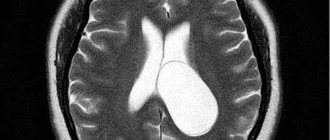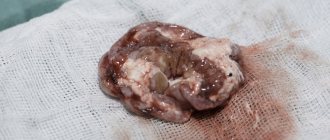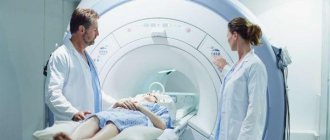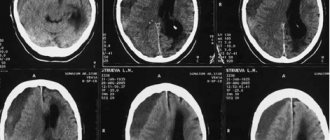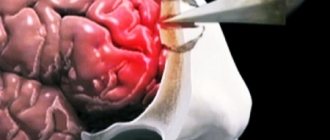Content:
- Why do alcoholics develop encephalopathy?
- Classification of the disease
- What does diagnostics include?
- How is the treatment carried out?
2.1. Acute alcoholic encephalopathy2.2. Chronic alcoholic encephalopathy
Alcoholism affects all vital organs and, first of all, the brain.
Alcohol literally destroys its cells, which leads to serious disorders and changes. One of the complications of addiction is alcoholic encephalopathy. This disease manifests itself at the end of the second - beginning of the third stage of alcoholism. It requires serious treatment, as it can lead to the most unfavorable consequences:
- severe mental disorders;
- dementia;
- complete or partial loss of memory;
- pseudoparalytic syndrome;
- of death.
Treatment of alcoholic encephalopathy must be carried out in a specialized hospital. At home, it is impossible to completely eliminate the signs of the disease and normalize the patient’s condition.
What is alcoholic encephalopathy?
Toxic alcoholic encephalopathy of the brain is a disease that is accompanied by degeneration of brain cells under the influence of ethyl alcohol and its metabolites. The code for alcoholic encephalopathy according to the ICD 10 classifier is G31.2 “Degeneration of the nervous system caused by alcohol.”
As a rule, the disease occurs at the junction of stages II and III of chronic alcoholism. The period of regular consumption of alcoholic beverages at the time the first signs of the disease appear varies from 7 to 20 years, but an earlier onset of the disease is possible; this depends largely on the individual characteristics of the body. In rare cases, symptoms appear in the absence of alcoholism, against the background of periodic drinking.
Alcoholic encephalopathy
The disease manifests itself in a variety of neurological disorders (one of the most common is encephalopolyneuropathy), disorders in the emotional and intellectual spheres.
Why do alcoholics develop encephalopathy?
Due to constant drinking
In high doses, metabolic processes in the human body begin to proceed incorrectly, and an acute deficiency of vitamin B1 develops. Gradually, metabolic disorders spread to the brain. Its capillaries become thinner, and severe swelling may develop.
The likelihood of developing a disease is very high if an alcohol addict often takes surrogates for alcohol or independently prepares “hot drinks” from various technical liquids containing alcohol. Indeed, in this case, acute intoxication occurs many times faster.
Signs
A prerequisite for the development of any alcoholic encephalopathy is chronic alcoholism in a person. As a rule, the disease develops at the end of the second and third stages of alcoholism. In women with constant abuse of ethanol, encephalopathy can be diagnosed 3-4 years after the start of drinking alcohol. The life expectancy of patients with alcoholic encephalopathy averages from 6 to 20 years.
Prodromal period
The prodromal period is characteristic of acute and chronic encephalopathies and can last from several weeks to several months. During this period, a person exhibits nonspecific symptoms: malaise, loss of appetite, general weakness, decreased mood, and others. Asthenic phenomena predominate and can lead to aversion to food and a sharp decrease in physical activity. A person is worried about heartburn, nausea, stool disorders, and changes in blood pressure. Changes in sleep occur in almost all patients. Drowsiness appears during the daytime and insomnia at night, nightmares occur, sleep becomes intermittent and superficial.
A person complains of palpitations, body aches, chills, which are replaced by a feeling of heat. There is trembling in the hands, headaches, dizziness. During the prodromal period, a person continues to abuse alcoholic beverages, which aggravates the general condition.
Acute encephalopathies
People who drink alcohol for a long time develop vitamin B deficiency, which leads to the development of encephalopathy.
According to the severity and duration of the disease, acute encephalopathies are divided into three types:
- Acute alcoholic Wernicke's encephalopathy.
The cause of the development of Wernicke's encephalopathy is a deficiency of thiamine (vitamin B1), which is formed in people with prolonged alcohol consumption, fasting, or disruption of food absorption in the digestive tract due to other diseases. The exact mechanism of damage to the structures of the central nervous system due to vitamin B5 deficiency is not known, but it has been established that the gray matter of the brain, mamillary bodies, thalamus and cerebellum are primarily affected. Degenerative processes occur in nerve cells (neurons), microhemorrhages.
CM. SEE ALSO: Diabetic encephalopathy: features of the course and treatment
The clinical picture is dominated by a triad of symptoms:
- Ophthalmoplegia is a complete absence of voluntary movements of the extraocular muscles, which are responsible for the movements of the eyeballs. In the clinic, this is manifested by the development of strabismus or immobility of the eyes. Strabismus can be unilateral or bilateral, convergent or divergent. Horizontal or vertical large-scale nystagmus is often detected. Nystagmus is oscillatory movements of the eyeballs with a certain amplitude.
- Ataxia is a violation of motor coordination that occurs when the cerebellum and vestibular nerve nuclei are damaged. The person's gait is disturbed. It becomes unsteady, leads to falls and is accompanied by dizziness.
- Impaired consciousness. A person's concentration of attention decreases, memory deteriorates, inhibition of thinking and difficulty in learning new information appear. In severe cases, confusion and stupor occur, which may give way to coma.
They identify mental disorders that manifest themselves as visual, tactile, and verbal hallucinations. A person sees a snake instead of a crack on the wall or hears someone else's speech, tries to turn on an imaginary tap, talks to himself. In severe cases, hallucinations cease to be combined with the environment, the person is in a fictional space, but orientation remains in his own personality. As the disease progresses, drowsiness and apathy appear during the daytime, and hallucinations resume at night.
In severe cases, the hypothalamus is affected, which leads to a drop in blood pressure and the development of coma. Death occurs in the absence of treatment as a result of disruption of the regulation of the body's autonomic reactions by the hypothalamus (blood pressure, heart rate, vascular tone, etc.).
An early sign of recovery is normalization of sleep.
- Acute mitigated alcoholic encephalopathy.
The disease begins with a prodromal period, which is characterized by the appearance of nonspecific symptoms. Fatigue, loss of appetite, general weakness, and sleep disturbance appear. A person’s mood decreases, emotional depression appears, preoccupation with his condition and a search for non-existent diseases in himself. On the part of the peripheral nervous system, neuritis is diagnosed - damage to the nerve fibers that innervate a certain area. Neuritis is accompanied by pain, tingling or numbness. The prodromal period lasts on average 1-2 months and is replaced by the appearance of delirium. Delirium is auditory and visual hallucinations that are accompanied by delirium. The patient speaks out, talks to imaginary subjects, and does not come into contact with others. After the mitigated encephalopathy subsides, residual effects are revealed in the form of memory disorders that are difficult to treat. Neurological disorders associated with the development of delirium are insignificant.
- Fulminant encephalopathy (hyperacute form).
It is characterized by a rapid onset and a high incidence of deaths on days 2-5 from the onset of the disease. The prodromal period lasts about 2-3 weeks and is replaced by the development of psychosis, which is represented by occupational delirium (the patient believes that he is at work).
A person’s body temperature rises to 40-41 C, which is difficult to bring down with antipyretic drugs. Consciousness is impaired to the point of coma.
Chronic encephalopathies
The clinical picture of Korsakov's psychosis is dominated by memory impairment
- Korsakov psychosis.
It is believed that the basis of the disease is damage to the nuclei of the thalamus against the background of long-term alcoholism. More often it develops after alcoholic psychosis, which was accompanied by severe hallucinations. The clinical picture is dominated by memory disorders in the form of loss of life episodes of varying duration that preceded the disease (retrograde amnesia) and the inability to remember new information (fixation amnesia). Such patients cannot remember the room number, the address of the hospital, what they ate for breakfast and other points, but they remember long-ago events well. Memory impairment does not upset patients and they are not concerned about their condition. Another symptom of Korsakoff psychosis is false memories. They arise in response to questions that are asked to a sick person, and he replaces “memory lapses” with fictitious events. Patients may be disoriented in place, time and people around them. Easily fatigued and lack of interest in the world around us is revealed.
- Alcoholic pseudoparalysis.
CM. SEE ALSO: Diabetic encephalopathy: features of the course and treatment
The disease manifests itself with psychopathological and neurological symptoms.
Psychopathological symptoms are represented by the patient’s ideas of his own greatness, lack of criticism of his behavior and the behavior of those around him, and euphoria. From the nervous system, tremors are detected in the hands, tongue and facial muscles. Speech becomes slurred, memory is impaired, and convulsive seizures may occur. Alcoholic pseudoparalysis during treatment can completely stop or, conversely, progress. This depends on the patient’s concomitant and previous diseases.
Classification of the disease
Alcoholic encephalopathy is usually classified into:
- spicy;
- chronic.
Let's look at the symptoms of each type in more detail.
Acute alcoholic encephalopathy
It starts with warning symptoms. The patient complains of insomnia, loss of appetite, and increased fatigue. He cannot eat foods containing high amounts of protein and fat. He always tries to eat dishes rich in quickly digestible carbohydrates. As a result, metabolic failure becomes even more pronounced, as does a deficiency of vitamins and microelements. A little later, pain begins in the stomach, in the right hypochondrium, nausea in the morning, heartburn and diarrhea.
Gaye-Wernicke encephalopathy, one of the acute forms of the disease, usually begins with delirium. The patient sees hallucinations, constantly mutters something, and behaves inappropriately. Periodically he experiences painful cramps. The face may swell greatly, which seems unnatural given the overall thinness.
At a certain moment, the pulse skips a beat, body temperature rises, and blood pressure drops.
An alcoholic may fall into a coma. A fatal outcome cannot be ruled out. According to statistics, most often it occurs two weeks after the first signs of encephalopathy appear. If events develop favorably, the so-called psychoorganic syndrome occurs. It manifests itself:
- mental helplessness;
- memory loss;
- complete loss of volitional abilities;
- inability to adapt to new conditions;
- apathy.
Symptoms
P.).
When the disease spreads to the spinal cord tissue, sensitivity is impaired and pathologies of the pelvic organs appear.
Basically, the course of toxic encephalopathy depends on which parts of the brain are affected by toxic substances.
Symptoms are very extensive and are divided depending on the form of the disease:
- Asthenia is a painful condition associated with a feeling of weakness, drowsiness, and unreasonable fatigue. thinness.
- Adynamia – a sharp loss of strength, muscle weakness, low motor activity.
- Disturbances in the functioning of the digestive system (nausea, frequent vomiting, especially in the morning, diarrhea/constipation, pain localized in the abdominal area, heartburn, belching).
- Sleep disorders.
- Excessive sweating.
- Pain localized in the heart area, accompanied by shortness of breath and a feeling of tightness in the chest.
- Aches, numbness, pain in the limbs.
- Impaired consciousness, speech dysfunction.
- Anxiety.
- Characteristic twitching, trembling of the face, lips, tongue.
- Deterioration of vision, retinal hemorrhages.
- Puffiness, swelling of the face and upper torso.
- Fever.
- The skin of the face acquires a characteristic earthy color, and a pronounced greasy coating is observed. The skin of the body, on the contrary, peels off, becomes flabby, and acquires necrotic lesions - bedsores - if there is insufficient care.
- Dizziness.
- Nervous disorders, including lesions of the vestibular apparatus, lack of ability to move independently, walking from heel to toe.
- Disorientation, memory loss.
- Polyneuritis accompanied by mild paresis.
- Epileptic seizures.
Symptoms vary depending on the severity of the disease, as well as the health status of the person. Common to all forms of pathology are the following symptoms:
- tremor of the limbs, which increases with prolonged absence of alcohol in the blood;
- lack of appetite;
- sudden weight loss;
- insomnia;
- loss of interest in life;
- unstable psyche;
- increased swelling of the face and upper body;
- sudden changes in body temperature to critical levels;
- arrhythmia and tachycardia;
- temporal and spatial disorientation;
- frequent limb cramps;
- decreased reaction speed, lethargy;
- aggression in behavior;
- anxiety and fearfulness;
- degradation and immoral lifestyle.
What is alcoholic encephalopathy and how to deal with it? After excessive alcohol consumption, the body is subjected to severe toxic poisoning. Well, if this intake is systematic and regular, then the toxins contained in alcohol gradually kill the drinker’s body.
One of the consequences of alcoholism is cerebral encephalopathy. The main symptoms are mental disorders that occur against the background of the death of brain cells. This disease belongs to a group of similar ailments that have the same pattern of manifestation.
Alcoholic encephalopathy: causes of occurrence
The signs by which the disease is determined is that the body stops producing vitamin B1. Responsible for the balance of carbohydrate metabolism. After drinking a fair amount of alcohol, it tends to become lower and the brain begins to suffer from carbohydrate deficiency.
We recommend! Harmful CHOLESTEROL has a detrimental effect on the functioning of the cardiovascular system, leading to the development of life-threatening diseases. Find out a cheap method to cleanse your blood of bad cholesterol!
Its symptoms may include the following:
- Lack of appetite accompanied by pain in the abdomen, heartburn, nausea or vomiting.
- The stomach stops functioning normally.
- Severe food malnutrition.
- Feelings of cold and yeast in the muscles, symptoms of general weakness.
- Involuntary symptoms of twitching of the facial muscles, arms and legs.
- Swelling of brain tissue.
- Restless and frequently interrupted sleep.
- The heart rate becomes faster. Irregular heart rhythm.
- Excessive sweating may be accompanied by loss of spatial coordination and a feeling of shortness of breath.
- Liver dysfunction.
- Fainting or symptoms preceding it.
- A sharp increase in body temperature parameters from normal to 40 degrees.
Mitigated encephalopathy is the second acute form of the pathology. It is characterized by:
- constant depressed mood;
- sleep disorder;
- high level of anxiety;
- sudden memory loss.
After drug correction of the condition, the patient may suffer from amnesia symptoms for a long time. It is difficult for him to remember moments from the past. Even what happened to him yesterday, he cannot always retell and describe.
The hyperacute form is another type of acute alcoholic encephalopathy. It is characterized by rapid progression and is therefore very dangerous. Often results in death.
Before a person encounters a dangerous disease, he may notice warning signs within three weeks. Afterwards, severe psychosis develops, consciousness is impaired, and body temperature rises to 41°C. In just a few days the person falls into a coma and dies. If he manages to survive, he is faced with pseudoparalytic syndrome. The latter is characterized by a euphoric mood, absurd delusions of grandeur in the absence of progressive paralysis.
Chronic alcoholic encephalopathy
The chronic form of encephalopathy can manifest itself as Korsakoff psychosis and alcoholic pseudoparalysis. The first one is encountered more often by female representatives. The disease is characterized by memory loss, difficulties with spatial orientation, and poor motor reactions and speech. The patient may also experience neuritis.
Pseudoparalysis occurs more often in men. The patient develops dementia, loses many knowledge and skills, and suffers from constant sudden mood swings. His hands are shaking, his speech is impaired.
Diagnostics
It is not difficult even for a non-medic to recognize encephalopathy in a person. The symptoms are pronounced. To make sure the diagnosis is correct, you should definitely consult a doctor, who will prescribe all the necessary tests.
Carrying out diagnostics:
- Ultrasound of internal organs and blood vessels. Especially the liver, kidneys, and intestines.
- MRI of the brain. This is the most important screening, which will give an accurate picture of the state of the cerebral vessels, the state of neurons and connections between them, the state of gray and white matter, as well as the cerebral cortex.
- Biopsy if necessary. If dark areas are visible and the doctor suspects the presence of other diseases, then a biopsy is performed, which makes it possible to make an absolutely accurate diagnosis.
- Taking external indicators. A professional doctor who often encounters cases of encephalopathy is able to make a diagnosis literally right away. He focuses on the patient’s appearance, the condition of the skin and mucous membranes. By asking the right questions and receiving answers to them, the doctor makes a diagnosis of encephalopathy. All other tests are prescribed only to determine the stage of the disease.
- General urine and blood tests, ECG and other types of studies are also necessary to understand at what stage the disease is progressing.
There are other research methods. But, first of all, close people and relatives should pay attention to the deterioration of their health. An alcoholic is unable to make the right decisions on his own. He cannot adequately respond to the deterioration of his health. And even death does not scare him.
The disease progresses so much that the patient does not have time to respond to the course of its development.
How is the treatment carried out?
The amount of medical care that needs to be provided to a patient directly depends on the form of the disease and the severity of the patient’s condition. To speed up the cleansing of the body from toxic compounds and to put metabolic reactions in order, intensive infusion therapy is carried out. Medications that help with psychosis are administered intravenously to a person using a drip. With their help, a narcologist can:
- remove existing metabolic disorders;
- restore normal breathing;
- prevent the development of severe diseases of the kidneys, liver, heart, lungs, and gastrointestinal tract;
- remove hyperthermia.
Additionally, the addict is prescribed symptomatic treatment aimed at eliminating the symptoms of emerging pathologies of the liver, kidneys, cardiovascular system, etc. The treatment regimen necessarily includes taking vitamin and mineral formulations, since without them it is impossible to normalize metabolism.
It is very important that the treatment of alcoholic encephalopathy is carried out by a highly qualified narcologist. If the patient and his relatives ignore the first dangerous “bells” signaling brain damage, then the disease will not be long in coming. Starting treatment at the beginning of the pathological process allows doctors to achieve excellent results, which is why it is so important not to delay seeking medical help.
Need some advice?
OR CALL A DOCTOR
CALL!
+7
What are the forecasts
Forecasts that relate directly to alcoencephalopathy directly depend on the type and stage of the disease. Acute types of pathologies rarely go away completely without consequences. In the vast majority of diagnosed cases, they are fatal. Survivors develop various serious complications that significantly reduce the quality and length of life.
But timely, competent therapy using innovative therapy developments allows one to achieve better results. It must be remembered that treating encephalopathy at the stage of alcohol addiction is much more difficult than preventing its development. That is why you should reconsider your own lifestyle and give up alcohol abuse.
Causes of the disease
Pathology is formed as a consequence of chronic intoxication with alcohol, especially low-quality drinks and substitutes. These patients have a history of repeated hospitalization due to alcohol intoxication.
However, chronic alcoholism does not directly affect the development of the disease. Constant intake of doses of alcohol disrupts the correct course of the metabolic process and provokes an imbalance of minerals and vitamins, primarily group B (B1 and B6). Aldehydes—alcohol breakdown products—damage nerve cells. Those, in turn, are insufficiently supplied with oxygen and nutrients. And brain intoxication, disruption of the nervous system manifests itself in mental disorders.



